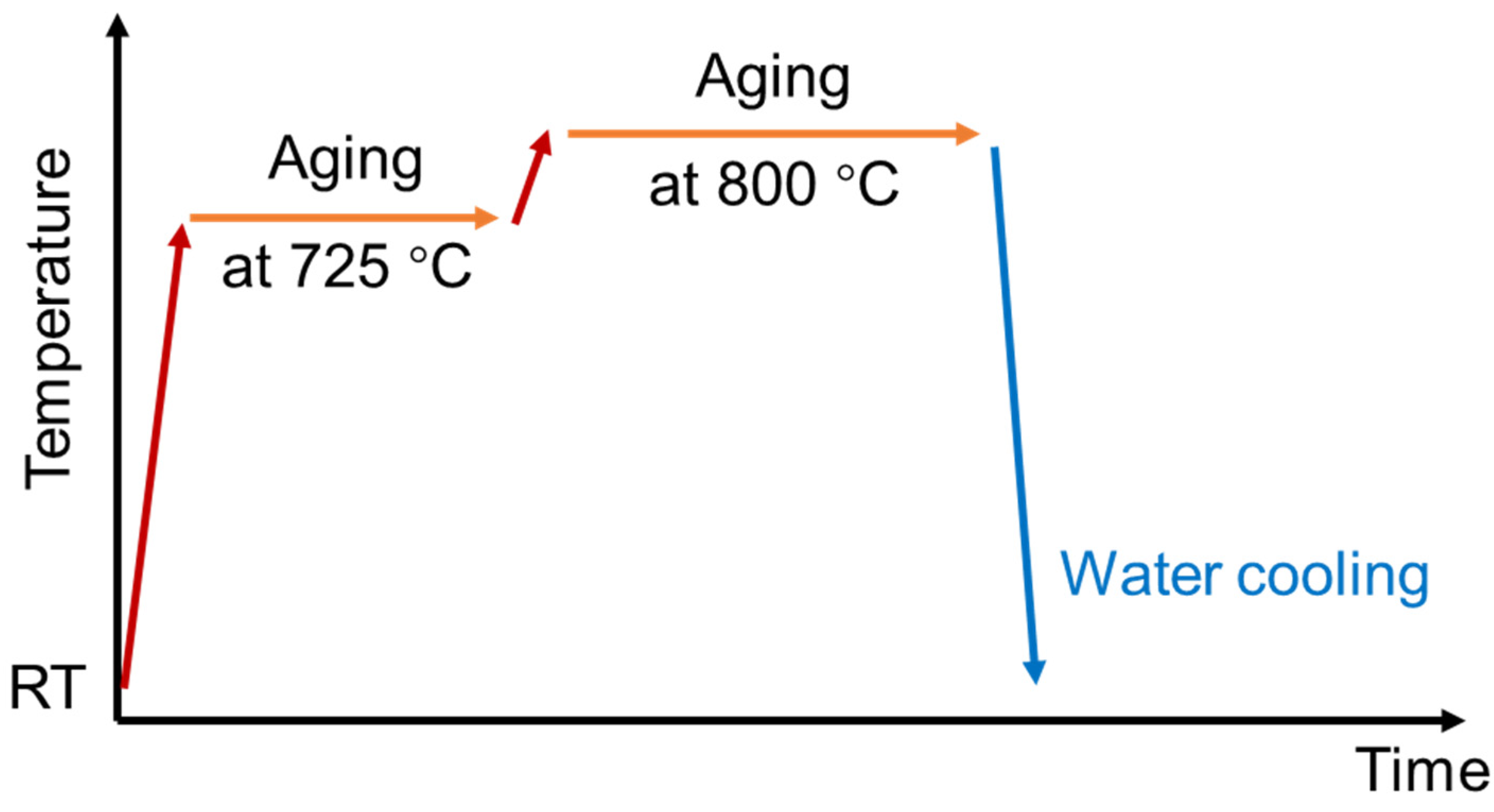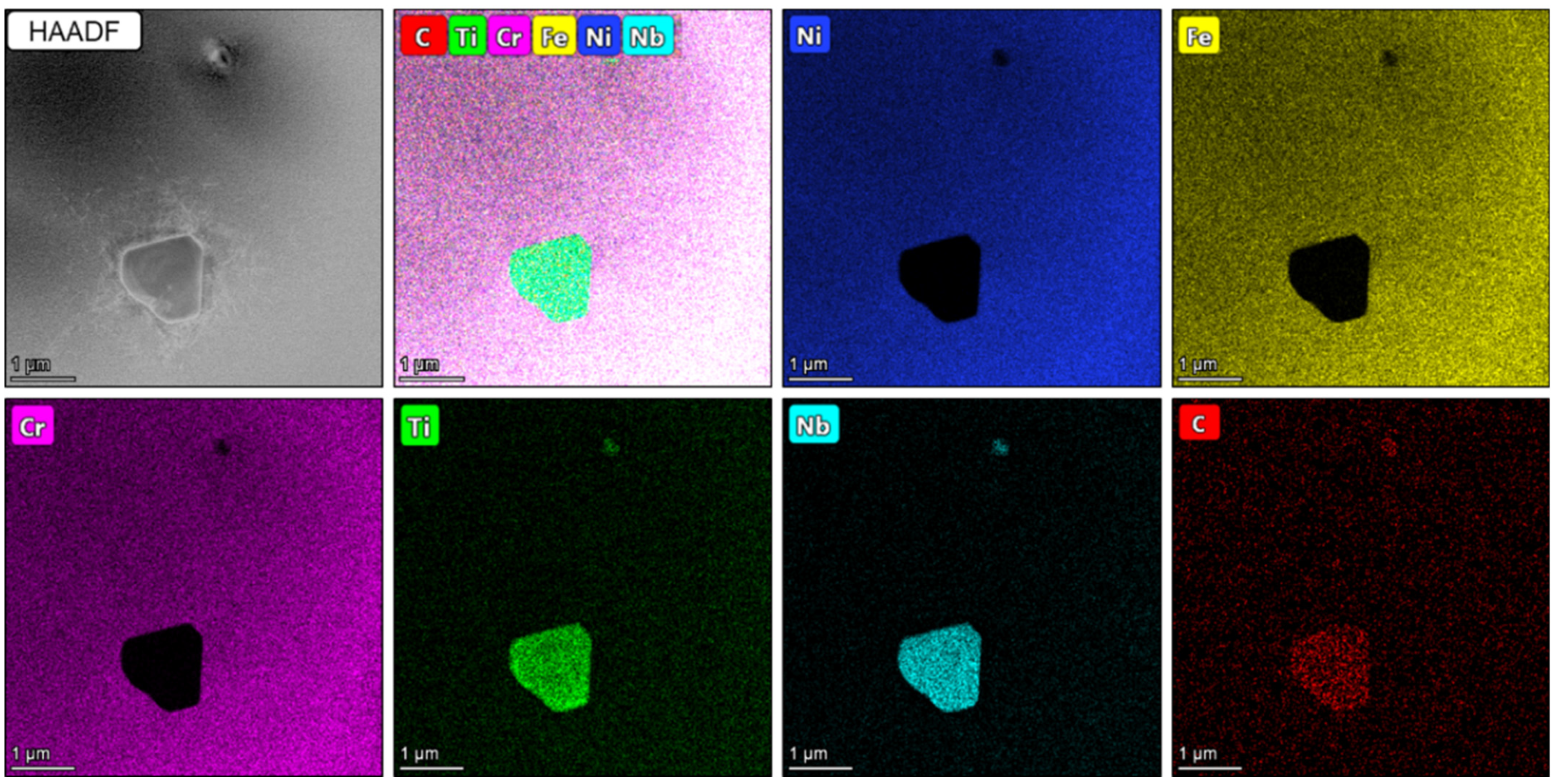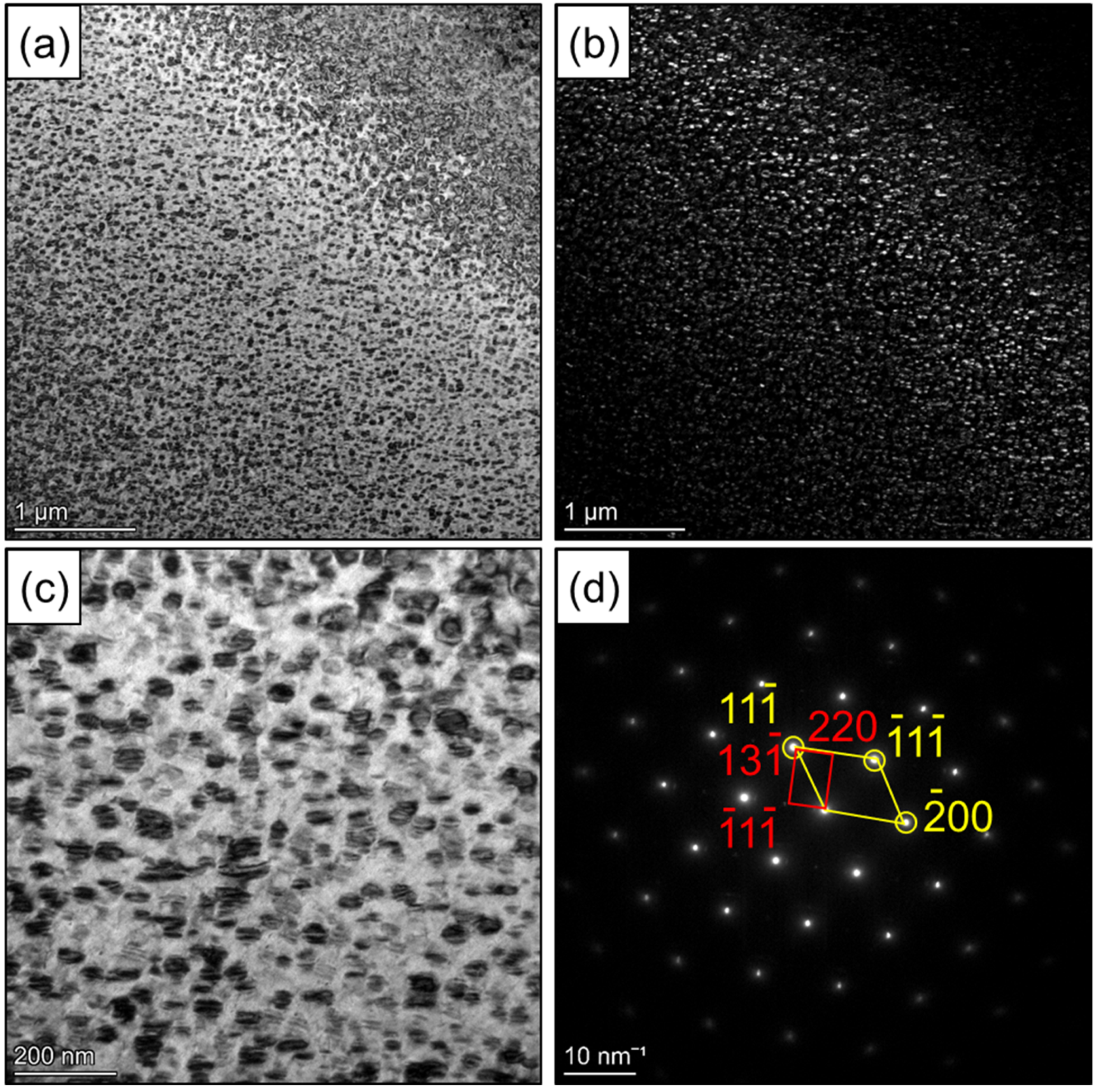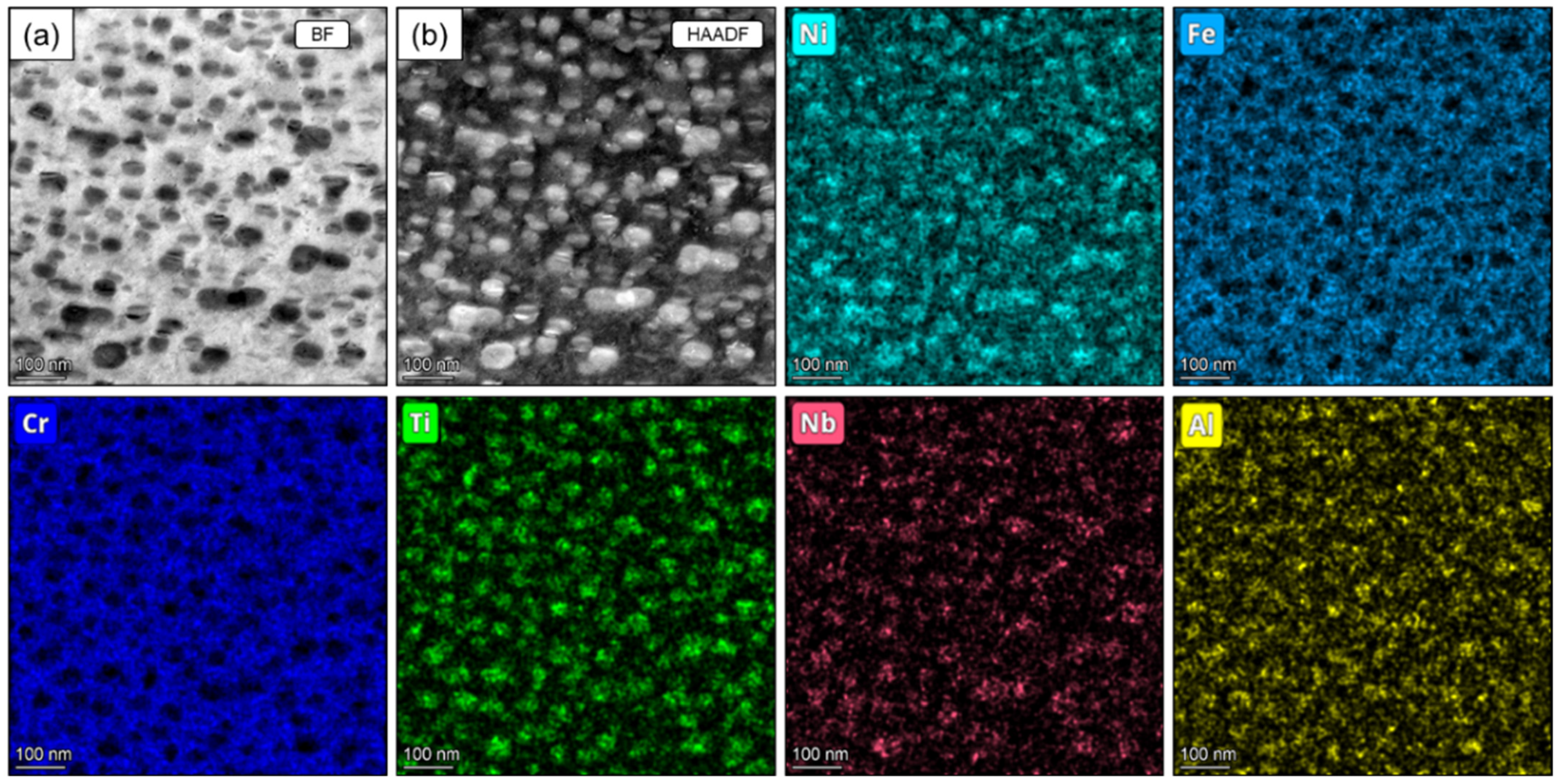Excellent Double-Aging Strengthening Effect with the High Density γ’ Phase of 945A Nickel-Based Alloy
Abstract
:1. Introduction
2. Materials and Methods
3. Results
4. Discussion
4.1. γ’ Phase Evolution during the Double-Aging Treatment
4.2. Strengthening Mechanism of the γ’ Phase
5. Conclusions
- (1)
- The double-aging treatment significantly improves the compressive yield stress. The 5# sample exhibits the highest compressive yield stress of 1007 MPa, which exceeded that of the original state of 229 MPa.
- (2)
- With the increment in the double-aging time, the size of the γ’ phase particle improves, and the interspace is reduced. The γ’ phase particle size of the 5# sample is about 50 nm, and the interspace between each precipitate is about 20 nm.
- (3)
- The high density of the γ’ phase is attributed to the formation of many fine γ’ phase nucleation points in the first aging process. In addition, the increased system energy caused by the defects potentially promotes the occurrence of a spinodal decomposition mechanism, which can generate more and faster new phase nuclei.
- (4)
- The strengthening mechanism is mainly attributed to the Orowan strengthening mechanism. After double-aging treatment, a high density of the γ’ phase precipitates occurs, which effectively improves the strength. This strengthening effect of double-aging treatment is better than that of direct aging.
Author Contributions
Funding
Institutional Review Board Statement
Informed Consent Statement
Data Availability Statement
Conflicts of Interest
References
- Collins, D.M.; D’Souza, N.; Panwisawas, C.; Papadaki, C.; West, G.D.; Kostka, A.; Kontis, P. Spinodal Decomposition versus Classical γ′ Nucleation in a Nickel-Base Superalloy Powder: An In-Situ Neutron Diffraction and Atomic-Scale Analysis. Acta Mater. 2020, 200, 959–970. [Google Scholar] [CrossRef]
- Ezugwu, E.O.; Wang, Z.M.; Machado, A.R. The Machinability of Nickel-Based Alloys: A Review. J. Mater. Process. Technol. 1999, 86, 1–16. [Google Scholar] [CrossRef]
- Berthod, P.; Lemoine, P.; Aranda, L. Experimental and Thermodynamic Study of Nickel-Based Alloys Containing Chromium Carbides, Part I: Study of the Ni–30 wt% Cr–xC System over the [0–2.0 wt% C] range. Calphad 2008, 32, 485–491. [Google Scholar] [CrossRef] [Green Version]
- Cutler, E.R.; Wasson, A.J.; Fuchs, G.E. Effect of Minor Alloying Additions on the Carbide Morphology in a Single Crystal Ni-Base Superalloy. Scr. Mater. 2008, 58, 146–149. [Google Scholar] [CrossRef]
- Wang, K.; Du, D.; Liu, G.; Pu, Z.; Chang, B.; Ju, J. A Study on the Additive Manufacturing of a High Chromium Nickel-Based Superalloy by Extreme High-Speed Laser Metal Deposition. Opt. Laser Technol. 2021, 133, 106504. [Google Scholar] [CrossRef]
- Lin, Y.C.; Wang, C.Y. Alloying-Element Dependence of Structural, Elastic and Electronic Properties of Nickel-Based Superalloys: Influence of γ’ Volume Fraction. J. Alloy. Compd. 2020, 838, 155141. [Google Scholar] [CrossRef]
- Edtmaier, C.; Wolf, M.; de Oro Calderon, R.; Schubert, W.-D. Effect of Nickel on the Formation of γ/γ’ Microstructures in WC/Co-Ni-Al-W. Int. J. Refract. Met. Hard Mater. 2021, 100, 105652. [Google Scholar] [CrossRef]
- Li, J.; Ding, R.; Guo, Q.; Li, C.; Liu, Y.; Wang, Z.; Li, H.; Liu, C. Effect of Solution Cooling Rate on Microstructure Evolution and Mechanical Properties of Ni-Based Superalloy ATI 718Plus. Mater. Sci. Eng. A 2021, 812, 141113. [Google Scholar] [CrossRef]
- Saleem, B.; Dong, H.B.; Patel, V. Effect of Aging on the Strength of Corrosion-Resistant Incoloy Alloys 945 and 945X: A Microstructural Perspective. Mater. Sci. Eng. A 2019, 748, 327–336. [Google Scholar] [CrossRef]
- Flageolet, B.; Jouiad, M.; Villechaise, P.; Mendez, J. On the Role of γ Particles within γ′ Precipitates on Damage Accumulation in the P/M Nickel-Base Superalloy N18. Mater. Sci. Eng. A 2005, 399, 199–205. [Google Scholar] [CrossRef]
- Vernier, S.; Franchet, J.-M.; Dumont, C.; Vennéguès, P.; Bozzolo, N. γ′ Precipitates with a Twin Orientation Relationship to Their Hosting Grain in a γ-γ′ Nickel-Based Superalloy. Scr. Mater. 2018, 153, 10–13. [Google Scholar] [CrossRef]
- Kim, I.; Song, M.; Kim, J. Nanocluster Formation and Two-Step Aging Behavior in Al–Mg–Si(-xCu: X = 0–4 mass%) Alloys. J. Alloy. Compd. 2021, 857, 157596. [Google Scholar] [CrossRef]
- Gu, K.; Zeng, X.-Q.; Chen, B.; Wang, Y.-X. Effect of Double Aging on Mechanical Properties and Microstructure of EV31A Alloy. Trans. Nonferr. Met. Soc. China 2021, 31, 2606–2614. [Google Scholar] [CrossRef]
- Nick, M.; Feuerhack, A.; Bergs, T.; Clausmeyer, T. Numerical Investigation of Damage in Single-step, Two-step, and Reverse Deep Drawing of Rotationally Symmetric Cups from DP800 Dual Phase Steel. Proced. Manuf. 2020, 47, 636–642. [Google Scholar] [CrossRef]
- Wu, R.; Zhao, Y.; Yin, Q.; Wang, J.; Ai, X.; Wen, Z. Atomistic Simulation Studies of Ni-Based Superalloys. J. Alloy. Compd. 2021, 855, 157355. [Google Scholar] [CrossRef]
- Xia, W.; Zhao, X.; Yue, L.; Zhang, Z. A Review of Composition Evolution in Ni-Based Single Crystal Superalloys. J. Mater. Sci. Technol. 2020, 44, 76–95. [Google Scholar] [CrossRef]
- Long, H.; Mao, S.; Liu, Y.; Zhang, Z.; Han, X. Microstructural and Compositional Design of Ni-Based Single Crystalline Superalloys—A Review. J. Alloy. Compd. 2018, 743, 203–220. [Google Scholar] [CrossRef]
- Günther, K.; Bergmann, J.P. Understanding the Dissolution Mechanism of Fused Tungsten Carbides in Ni-Based Alloys: An Experimental Approach. Mater. Lett. 2018, 213, 253–256. [Google Scholar] [CrossRef]
- She, J.; Peng, P.; Tang, A.T.; Zhang, J.Y.; Mao, J.J.; Liu, T.T.; Zhou, S.B.; Wang, Y.; Pan, F.S. Novel on-Line Twist Extrusion Process for Bulk Magnesium Alloys. Mater. Des. 2019, 182, 108011. [Google Scholar] [CrossRef]
- She, J.; Zhou, S.B.; Peng, P.; Tang, A.T.; Wang, Y.; Pan, H.C.; Yang, C.L.; Pan, F.S. Improvement of Strength-Ductility Balance by Mn Addition in Mg–Ca Extruded Alloy. Mater. Sci. Eng. A 2020, 772, 138796. [Google Scholar] [CrossRef]
- Liu, H.; Wang, D.; Zhou, L.; She, J.; Wu, W. Significant Improvement of Strength in Wrought 945A Ni-Based Superalloy by Aging Treatment. Crystals 2021, 11, 627. [Google Scholar] [CrossRef]
- Li, F.; Fu, R.; Yin, F.; Feng, D.; Wang, H.; Du, G.; Feng, Y. Impact of γ′(Ni3(Al,Ti)) Phase on Dynamic Recrystallization of a Ni-Based Disk Superalloy during Isothermal Compression. J. Alloy. Compd. 2017, 693, 1076–1082. [Google Scholar] [CrossRef]
- Yamada, T.; Abe, E.; Osawa, C.; Yukawa, N. Prediction on Microstructure and Mechanical Properties of Hot Forged Ni-Based Super Alloy by Optimization Using Genetic Algorithms. Proced. Manuf. 2018, 15, 356–363. [Google Scholar] [CrossRef]
- Robouch, B.V.; Burattini, E.; Kisiel, A.; Suvorov, A.L.; Zaluzhnyi, A.G. Strained-Tetrahedra Statistical Model for Atomic Distances and Site Occupations in Ternary Intermetallic M3(XX′) Structures Ni3(AlFe) Case. J. Alloy. Compd. 2003, 359, 73–78. [Google Scholar] [CrossRef]
- Peng, P.; Zhang, K.; She, J.; Tang, A.; Zhang, J.; Song, K.; Yang, Q.; Pan, F. Role of Second Phases and Grain Boundaries on Dynamic Recrystallization Behavior in ZK60 Magnesium Alloy. J. Alloy. Compd. 2020, 861, 157958. [Google Scholar] [CrossRef]
- Peng, P.; She, J.; Tang, A.; Zhang, J.; Song, K.; Yang, Q.; Pan, F. A Strategy to Regulate the Microstructure and Properties of Mg-2.0Zn-1.5Mn Magnesium Alloy by Tracing the Existence of Mn Element. J. Alloy. Compd. 2022, 890, 161789. [Google Scholar] [CrossRef]
- Langelandsvik, G.; Furu, T.; Reiso, O.; Roven, H.J. Effects of Iron Precipitation and Novel Metal Screw Extrusion on Electrical Conductivity and Properties of AA1370 Aluminium. Mater. Sci. Eng. B 2020, 254, 114505. [Google Scholar] [CrossRef]
- Kim, D.; Kim, J.; Wenner, S.; Thronsen, E.; Marioara, C.D.; Holmestad, R.; Kobayashi, E. Precipitation Behavior of Al-Si-Cu-Mg(-Fe) Alloys by a Deformation-Semisolid Extrusion Process. Mater. Charact. 2021, 173, 110863. [Google Scholar] [CrossRef]
- Charpagne, M.A.; Polonsky, A.T.; Echlin, M.P.; Jacomet, S.; Jaeger, J.d.; De Graef, M.; Bozzolo, N.; Pollock, T.M. Growth Accidents Induced by Primary γ′ Precipitates in a Polycrystalline Nickel-Based Superalloy. Scr. Mater. 2020, 186, 109–113. [Google Scholar] [CrossRef]
- Zhou, X.; Darvishi Kamachali, R.; Boyce, B.L.; Clark, B.G.; Raabe, D.; Thompson, G.B. Spinodal Decomposition in Nanocrystalline Alloys. Acta Mater. 2021, 215, 117054. [Google Scholar] [CrossRef]
- Pandolfi, G.S.; Martins, S.C.; Buono, V.T.L.; Santos, L.A. Precipitation Kinetics of Ti3Ni4 and Multistage Martensitic Transformation in an Aged Ni–Rich Ni–Ti Shape Memory Alloy. J. Mater. Res. Technol. 2020, 9, 9162–9173. [Google Scholar] [CrossRef]
- Peng, P.; Tang, A.; Wang, B.; Zhou, S.; She, J.; Zhang, J.; Pan, F. Achieving Superior Combination of Yield Strength and Ductility in Mg–Mn–Al Alloys via Ultrafine Grain Structure. J. Mater. Res. Technol. 2021, 15, 1252–1265. [Google Scholar] [CrossRef]








| Alloy | Fe | Cr | Nb | Mo | Cu | Ti | Mn | Al | Other | Ni |
|---|---|---|---|---|---|---|---|---|---|---|
| 945A Ni-based alloy | 18.3 | 21.7 | 4.0 | 3.6 | 1.8 | 1.0 | 0.5 | 0.5 | 0.3 | 48.3 |
| Sample Number | Double-Aging Parameters | |
|---|---|---|
| First | Second | |
| 0# | None | None |
| 1# | 725 °C for 8 h | 800 °C for 6 h |
| 2# | 800 °C for 12 h | |
| 3# | 800 °C for 24 h | |
| 4# | 800 °C for 48 h | |
| 5# | 800 °C for 96 h | |
Publisher’s Note: MDPI stays neutral with regard to jurisdictional claims in published maps and institutional affiliations. |
© 2022 by the authors. Licensee MDPI, Basel, Switzerland. This article is an open access article distributed under the terms and conditions of the Creative Commons Attribution (CC BY) license (https://creativecommons.org/licenses/by/4.0/).
Share and Cite
Liu, H.; Wang, D.; Zhou, L.; She, J.; Peng, P.; He, Q.; Wu, W. Excellent Double-Aging Strengthening Effect with the High Density γ’ Phase of 945A Nickel-Based Alloy. Crystals 2022, 12, 175. https://doi.org/10.3390/cryst12020175
Liu H, Wang D, Zhou L, She J, Peng P, He Q, Wu W. Excellent Double-Aging Strengthening Effect with the High Density γ’ Phase of 945A Nickel-Based Alloy. Crystals. 2022; 12(2):175. https://doi.org/10.3390/cryst12020175
Chicago/Turabian StyleLiu, Haiding, Dongzhe Wang, Lingping Zhou, Jia She, Peng Peng, Qubo He, and Wei Wu. 2022. "Excellent Double-Aging Strengthening Effect with the High Density γ’ Phase of 945A Nickel-Based Alloy" Crystals 12, no. 2: 175. https://doi.org/10.3390/cryst12020175





